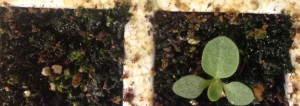Most growers seem satisfied with seed germination and seedling establishment in their greenhouses. In some of the earlier seeded greenhouses an application of fungicide has been made for control of Rhizoctonia damping-off. Clipping has started in some of the float tray greenhouses with more expected to start as the week progresses.
Last week signs of chilling injury were being seen in several greenhouses. The initial symptoms are often a bright yellow colour in the growing point of the seedling and upward cupping of the leaves. As the seedlings become larger and the leaves grow out (as shown below), some leaves will be malformed, cupped and have a distinct yellow/white discoloration. Chilling injury is caused by exposure of the seedlings to a large variation in air temperature, such as when ventilation occurs on a very cool but sunny day or at night when the temperature outside is quite cold and the temperature drops significantly in the greenhouse because the heaters do not have enough capacity to maintain the set temperature. Seedlings will outgrow chilling injury without any ill-effects.
At this time of year, it is not uncommon to see the after-effects that algae can have on young seedlings in trays. Seedling stands can sometimes be reduced significantly if enough algae is present when the seedlings are in the 2-leaf stage. Affected seedlings turn completely brown after they are overcome by the algae (as shown below). Cool and cloudy conditions are ideal for algal growth in trays. Conditions that are optimum in the greenhouse for rapid seed germination and early seedling growth help seedlings to outpace the algae so that the seedlings become large enough that the algae can no longer affect them. Not fertilizing for 2 or 3 weeks after seeding can also help to prevent an early buildup of algae in trays. Further information about algae can be found in the plant protection section of this website.
A few growers have asked about using a low-phosphorus fertilizer in dry tray greenhouses, such as a 12-2-14, which is commonly used in float tray greenhouses. A low phosphorous fertilizer is not recommended for use in dry tray greenhouses because it has been observed to cause phosphorous deficiency. This is when small, dark, circular shaped spots begin to appear on seedling leaves, which can look similar to the symptoms caused by target spot. The affected leaves then start to yellow. A fertilizer analysis of 20-20-20, 15-16-17 or 10-15-20 has been shown to provide good results in dry tray greenhouses.



